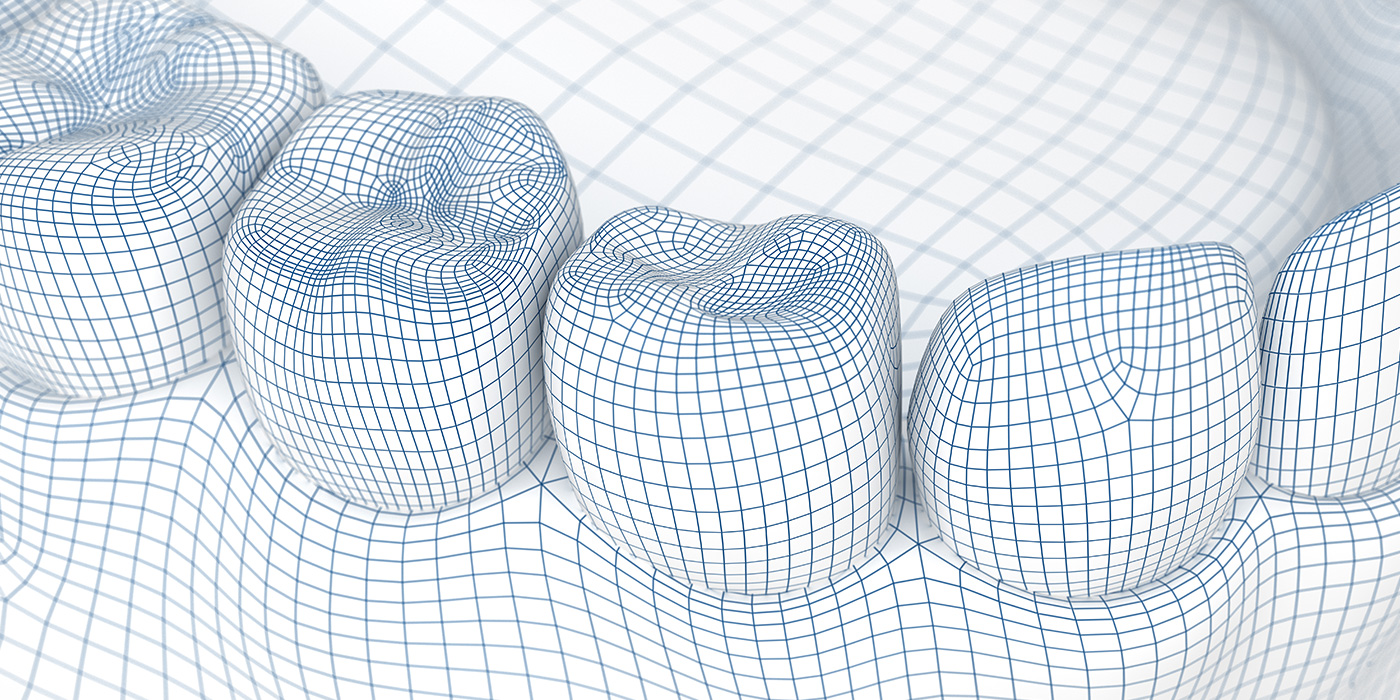Glass Ionomers in Dental Restorations and Fillings
Posted on Mar 27, 2019

It is widely known that eating sugary foods leads to a build-up of bacteria which can result in dental caries (tooth decay). The incidence of dental caries has fallen significantly since fluoride, which makes teeth more resilient to decay, was added to toothpaste. Nonetheless, the majority of dentist visits are still for the repair of teeth damaged by tooth decay. Indeed, in the US, 92% of adults and 21% of children have had dental caries in their permanent teeth.1
Tooth decay is caused by the acid produced by bacteria while they consume the sugars found in food and drink. This acid dissolves the protective enamel coating of teeth and then the dentine below. If the resultant cavity is not treated it can become painful, and this potentially leads to infection and even tooth loss.
The most common corrective action for tooth decay is to remove the decayed tooth tissue and fill the cavity with a filling material. There are several types of filling material currently available, including a variety of composite fillings, and the traditional silver amalgam. Composite filling materials are increasingly popular as many people prefer tooth-colored fillings that are less conspicuous. Composite dental materials can also be used for dental restorations to rebuild chipped or broken teeth. Most recently glass ionomer cements, which can be used in much the same way as composite materials, have been introduced as an additional alternative material for dental restoration.
The quality of a filling material is a key factor in determining the effectiveness of a repair. If the filling material is not durable it will be worn away during eating, and if it is prone to shrinkage bacteria will colonize the gap between the tooth and the filling giving rise to secondary caries.
The Materials used in Tooth Fillings
In the early days of modern dentistry (1800s), teeth were filled with any metal soft enough to mold into the cavity, eg, tin, silver. This advanced to dental amalgams containing a combination of metals including tin, silver, copper, and mercury as technology improved during the nineteenth century. By the end of the first quarter of the twentieth century silicate dental cements had been developed for both dental filling and the bonding of other dental restorations.2
Amalgam is still the most commonly used filling material today. Even after concerns were raised about the toxic effects of mercury, amalgam fillings continued to be used due to the inferior quality of alternatives. However, now that there are effective alternatives, which have the added aesthetic advantage of being tooth-colored, the proportion of amalgam fillings is steadily declining.
Today, there are several types of dental filling materials available, including silver amalgam, gold, porcelain, composite resins and glass ionomers. Although effective dental filling materials, gold and porcelain are rarely used due to their high costs. The other main options are compared below.
Amalgam
Amalgam is the least expensive of the dental filling materials and can be applied most quickly.2 It has the added benefit of being highly durable, lasting at least 10?15 years. There are, however, several drawbacks to the use of amalgam fillings, the most concerning of which is the potential toxicity from exposure to mercury during placement and removal of the amalgam, and also whilst in situ if an individual routinely grinds their teeth. The use of amalgam fillings also requires removal of some healthy tooth in order to create a space large enough to hold the amalgam. Lastly, the propensity of amalgam to expand and contract with changing temperature makes it more likely to crack or fracture and damage the surrounding tooth as a consequence of drinking hot and cold liquids.
Resin Composites
Dental composites can vary in formulation but all include a synthetic resin making them similar to plastics in composition. Initially, composite materials lacked the strength and durability of amalgam, but advances in their production mean that they can now be both strong and durable. Their main benefit is that they chemically bond to the tooth structure, providing further support and reducing the marginal gap that encourages bacterial colonization and increases the risk of secondary tooth decay. There is however a risk of subsequent shrinkage that can lead to gap development. Composite fillings are also aesthetically more pleasing since, unlike amalgam fillings, they blend in with the natural tooth surface. Unfortunately, composite materials are still considerably more expensive than amalgam (although still less expensive than gold or porcelain) and are more time-consuming to apply.2 Furthermore, the successful application of composite fillings is very technique sensitive and requires the area to be kept dry during placement.
Glass Ionomer Dental Cements
Glass ionomer cements (GIC) can have a variety of compositions, but the principal constituents are silica, alumina, and calcium. A source of fluoride, such as fluorite, is also commonly added to provide protection against tooth decay. Additional minerals can also be incorporated into the GIC to promote remineralisation and/or prevent acidification. The glass ionomer may be combined with resin for added strength, and to reduce the sensitivity to the presence of moisture on placement.3 GIC represent a very flexible dental restoration solution since the physical properties of GIC can be modified to meet a specific dental application by adjusting the ratios of the constituent chemicals.2
GIC, like resin composites, are tooth-colored and so have cosmetic appeal. The primary benefit of GIC is their chemical adhesion to enamel and dentin, which improves the strength of the restoration and eliminates the need for a bonding agent during placement.2,4 The bond strength of this adhesion is typically increased by addition of polycarboxylic acid. GIC have been reported to exhibit a contact-free area wear that is five times higher than that of amalgam and three times higher than for resin composite materials.2 Furthermore, in contrast to other restoration materials that can suddenly fail due to mechanical fatigue, GIC become stronger over time as water is absorbed and are thus less prone to failure.2
Most recently, GIC has been created using bioactive glass.5 Resin-modified GIC containing bioactive glass has been shown to result in a thick uniform layer of mineralization on the restoration-dentin interface,6 improve the mechanical properties of a filling,7 and reduced the incidence of secondary tooth decay at restoration margins.8
Conclusion
Despite silver amalgam being the mainstay dental filling material for many decades, there has been a desire to reduce its use due to toxicity concerns. Now that the alternative products available can provide comparable efficacy, the proportion of dental caries being corrected with amalgam fillings is declining. Advances in the formulations of composite and glass ionomer dental materials have given them the required strength and durability to make them effective products for tooth restoration. Although fillings with these newer materials are more expensive and take longer to place, they are often the preferred choice due to their improved aesthetics and low risk of toxicity.
Glass ionomer cements have the added benefits of flexibility in their physical characteristics, strong adhesion to the tooth surface and lower failure rate. The properties of both composite and glass ionomer dental materials can be improved by the inclusion of bioactive glass.
Mo-Sci produces a range of high quality glass and bioactive glass powders suitable for use as a dental filling materials and for the fixation or coating of dental implants.9 The precise composition of their glass products can be tailored to suit a specific application. Contact us for for more information.
References & Further Reading
- National Institutes of Health. NIDCR Data & Statistics. Dental Caries (Tooth Decay) in Adults (Age 20 to 64). Available at: https://www.nidcr.nih.gov/DataStatistics/FindDataByTopic/DentalCaries/DentalCariesAdults20to64.htm
- Lohbauer U. Dental Glass Ionomer Cements as Permanent Filling Materials? — Properties, Limitations Future Trends. Materials 2010, 3(1), 76-96; doi:10.3390/ma3010076
- Gao W, et al. Demineralization and remineraliza-tion of dentine caries, and the role of glass ionomer cements. Int Dent J. 2000;50(1):51–56.
- Benelli EM, et al. In situ anticariogenic potential of glass ionomer cement. Caries Res. 1993;27(4):280–284.
- Matsuya S, et al. Structure of bioactive glass and its application to glass ionomer cement. Dent Mater J. 1999 Jun;18(2):155–166.
- Prabhakar AR, et al Comparative Evaluation of the Remineralizing Effects and Surface Micro hardness of Glass Ionomer Cements Containing Bioactive Glass (S53P4):An in vitro Study. Int J Clin Pediatr Dent. 2010 May-Aug;3(2):69-77. doi: 10.5005/jp-journals-10005-1057. Available at https://www.ncbi.nlm.nih.gov/pubmed/27507915.
- Chatzistavrou X, et al. Fabrication and characterization of bioactive and antibacterial composites for dental applications. Acta Biomater. 2014;10:3723–3732. Available at https://www.ncbi.nlm.nih.gov/pubmed/24050766
- Khvostenko D, et al. Bioactive glass fillers reduce bacterial penetration into marginal gaps for composite restorations. Dental materials 2016;32(1):73–81. Available at http://www.demajournal.com/article/S0109-5641(15)00437-6/pdf
- Mo Sci Corporation website. http://www.mo-sci.com/en/products
